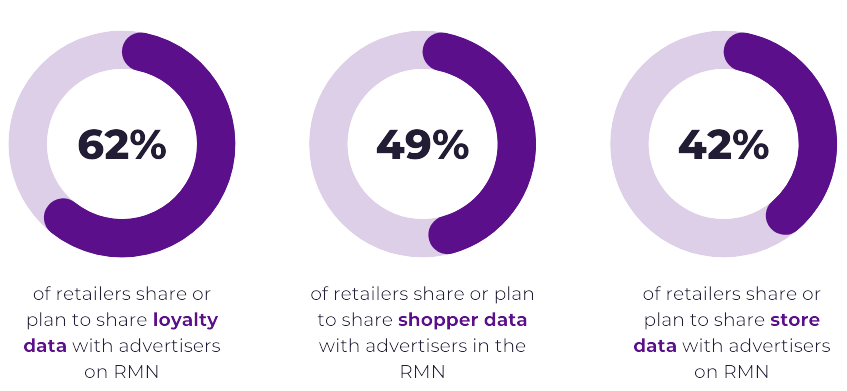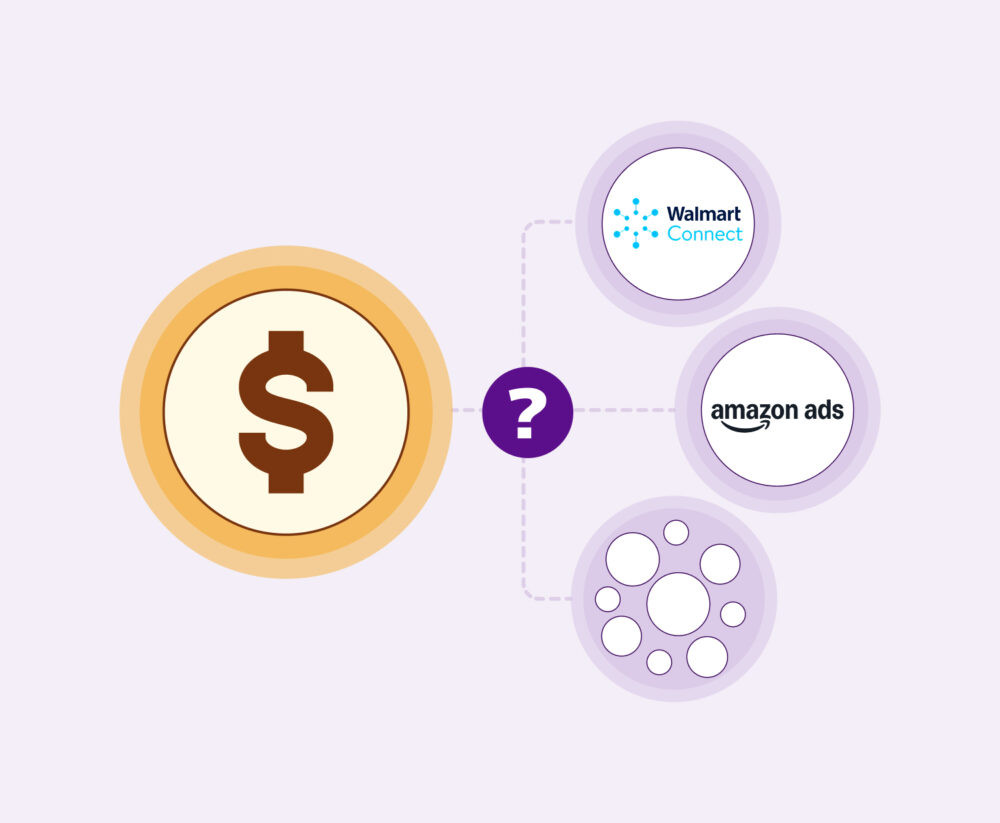Retail Media Networks: what are they and why are they important?
We’re at a point where brands are facing fierce competition in the market. Furthermore, there are increasing limitations on data protection, and many technological changes are coming, associated with the disappearance of third-party cookies.
In this context, Retail Media Networks (RMNs) are booming. In the first half of 2024, they’ve become one of the hottest topics in retail circles. And the growth doesn’t look like it’s going to stop any time soon. In December 2023, Deloitte published a survey of 450 of the largest retail companies in the United States. In this survey, 64% of retailers said that their plans included implementing a Retail Media network before the end of 2024.
It’s clear that Retail Media Networks have become a powerful tool for reaching consumers, both online and offline. They can be used to generate new experiences that attract consumers, converting their interest into purchases.
But what exactly are Retail Media Networks? Why are they making such an impact and are they so important? Let’s discover it together.
What are Retail Media Networks?
Retail Media networks are a type of advertising platform where retailers sell space on their digital channels to third parties. Companies that buy the advertising space offered by retailers can segment their ads using the 1st-party information that the retailer has about its customers.
Among digital RMNs are retailers’ websites, their mobile apps, or streaming services. But we can also find Retail Media networks in physical stores, via screens or displays placed in the store. And something we can’t lose sight of is that these networks represent a new source of revenue that retailers can exploit.
According to the forecast made by Emarketer, 18.5% of spending on advertising on Retail Media networks in 2024 will be on off-site ads, such as on third-party websites, apps, videos, or games.
Below we explain the different types of ads that can be placed on Retail Media Networks.
Types of ads on Retail Media Networks
There are 3 types of ads that can be published on a Retail Media network:
On-site
These are the ads that appear within the retailer’s own platform, such as on the websites of Amazon or Walmart. They can be display or search ads. These ads create a highly personalised and segmented shopping experience, which favours touchpoints between the advertiser and the consumer at the moment they have a special interest in buying.
Off-site
As we mentioned in the previous section, these are the ads that are published on third-party networks. They can take advantage of the enormous amount of 1st party information that retailers have about their customers. Sometimes the target audience of a brand is not found on their digital platform or in their store. But thanks to RMNs, we can go out and look for them wherever they are.
In-store
The third type of ad that can be found on a Retail Media network is the one that appears in physical stores. Personalising and defining the customer’s in-store shopping experience remains essential for brands and manufacturers. In-store ads can appear on digital screens or interactive signage, and be used to track customer behaviour in store in real time, just as you would in an online store.
We already know what the 3 types of ads that can be published on Retail Media Networks are, but what networks exist and which are the most used in the world?
The most used Retail Media Networks in the world
Currently, there are around 220 Retail Media networks in the world, a number that is increasing every day with the boom that RMNs are experiencing in 2024. These networks can be used by both online pure-players (such as eBay, for example) and by retailers that are only in the physical space (Walgreens), or by those who play in both channels. Everyone finds their place in these networks.
In addition, it should be taken into account that, for on-site advertising, retailers can use in-house technology (developed and customised for them), as in the case of Amazon. Or technology from other vendors, such as Criteo or CitrusAd.
Here is a list of the 15 most used Retail Media Networks in the world. This list includes networks from North America, EMEA, LATAM, and specific ones for Spain. It also details whether it is a retailer with a physical store or a marketplace, and the technologies it uses, both for on-site and for off-site.
| Retailer | Marketplace | Stores | RMN Name | Regions | On-Site Tech | Off-Site Tech |
|---|---|---|---|---|---|---|
| Walmart | Yes | Yes | Walmart Connect | North America | Criteo, Custom | The Trade Desk |
| Amazon | Yes | Yes | Amazon Advertising | North America, EMEA | Custom | |
| eBay | Yes | No | eBay Ads | North America, EMEA | Custom | |
| CVS | No | Yes | CVS Media Exchange | North America | Criteo | The Trade Desk |
| Target | Yes | Yes | Roundel | North America | Criteo, CitrusAd | The Trade Desk |
| Walgreens | No | Yes | Walgreens Advertising Group | North America | Criteo | The Trade Desk, Epsilon |
| Albertsons | No | Yes | Albertsons Media Collective | North America | Criteo, CitrusAd, Google | The Trade Desk |
| Carrefour | Yes | Yes | Unlimitail | EMEA, LATAM | CitrusAd | The Trade Desk, LiveRamp |
| Auchan | Yes | Yes | Valiuz Adz | EMEA | Criteo, Kamino Retail | Criteo |
| Leclerc | Yes | Yes | Consoregie | EMEA | Criteo | Mediarithmics |
| Mercado Libre | Yes | No | Mercado Ads | LATAM | Custom | |
| Glovo | No | No | Glovo Ads | LATAM, Spain | Topsort | Adsmovil |
| Drogasil | No | Yes | RD Ads | LATAM | ||
| PCComponentes | Yes | No | PCAds | Spain | Criteo | |
| MediaMarkt | No | Yes | MediaMarktSaturn Retail Media | EMEA, Spain | Criteo |
What are the benefits of using a retail media network?
Retail Media networks provide benefits for everyone: brands, retailers, and shoppers.
For brands, the biggest benefit lies in the 1st-party data that these networks can provide. According to the Deloitte survey we mentioned at the beginning of this article:

The benefit for retailers has already been mentioned above: the advertising spaces they sell on Retail Media Networks open up new avenues for them to generate revenue. It is estimated that, in 2027, 1 in 4 dollars spent on advertising will be spent on Retail Media. And this can bring huge economic benefits to retailers.
In addition, the economic benefit obtained thanks to RMNs allows retailers to remain competitive. In many cases, companies compete on price, logistics, or transport, which can significantly erode their profits. But by adopting new strategies to generate profits, such as Retail Media networks, retailers can better manage the constantly changing market landscape and ensure a good position.
Finally, consumers will benefit thanks to the hyper-segmentation and personalisation made possible by the data provided by Retail Media networks. They will be able to discover, try, and buy new brands that are perfectly tailored to their needs. And they won’t have to put up with so much advertising that hasn’t been specifically created to help them. Consumers will also benefit economically. The fact that retailers are reducing prices to stay competitive will directly impact consumers, who will pay less to acquire the products they want.
Why are Retail Media Networks important?
Retail Media Networks have become an essential tool in the current retail and advertising landscape. They are important because they offer brands the ability to reach consumers directly and effectively at the point of purchase, leveraging first-hand data for precise segmentation and personalisation. This not only optimises the user experience, but also increases conversion rates, by connecting consumers with products that they are genuinely interested in.
For retailers, RMNs open up new revenue streams, diversifying their business model in a highly competitive environment with constantly pressured profit margins. By incorporating these networks, retailers not only increase their profitability, but also strengthen their relationships with brands, facilitating deeper and mutually beneficial collaborations.
In short, Retail Media Networks are redefining marketing and sales strategies, driving both innovation and growth in the retail sector.



